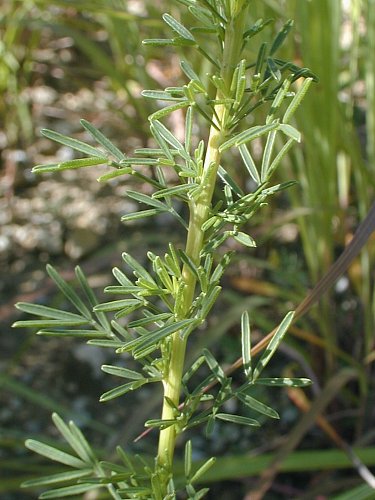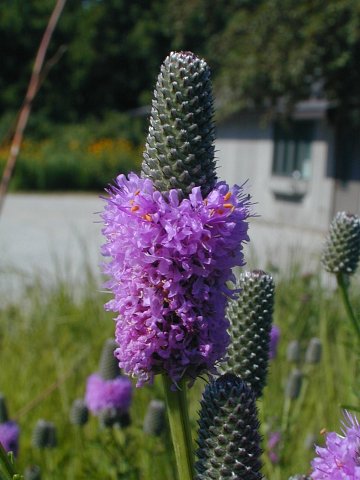Description: This herbaceous perennial plant is unbranched and ¾–3' tall. Older plants may tiller at the base and send up multiple stems, creating a bushy effect. The central stem is slightly ridged and hairless. The odd-pinnate compound leaves alternate as they ascend the stem. They consist of 3-7 leaflets and tend to be quite short, approximately 2-5" long. Each leaflet is dark green, linear in shape, and about 1" long and 1/8" (3 mm.) across. There are scattered translucent dots across the surface. At the top of the plant is a dense cylindrical spike of flowers about 1-2" long and about half as much or less across. Each purple flower is about ¼" across, with 5 small petals and 5 golden anthers that protrude outward. These flowers bloom together as a flowery wreath at the bottom of the spike, which gradually moves upward at the season progresses. There is no noticeable floral scent. The blooming period occurs from early to mid-summer, and lasts about 1–1½ months. The root system consists of a stout taproot that runs deep into the ground. The seeds travel only a short distance from the mother plant when the cylindrical spikes are shaken by the wind.

Cultivation:
The
preference is full sun and average to dry conditions. The soil can
contain significant amounts of loam, clay, sand, or gravel – this plant
is rather indifferent to the characteristics of the soil, to which it
adds nitrogen. Foliar disease is not troublesome. Purple Prairie Clover
is slow to develop, but is fairly easy to manage if the site is
well-drained and there is plenty of sun.
Range & Habitat:
The native Purple Prairie Clover occurs occasionally in central and
northern
Illinois, but is rare or absent in southern Illinois (see Distribution
Map). It is not common in areas that have been disturbed by
modern development. Habitats include mesic to dry black soil prairies,
gravel prairies, sand prairies, hill prairies, typical savannas and
sandy savannas, limestone glades, and sandy hills or dunes near Lake
Michigan. Recovery from occasional wildfires is good.

Faunal Associations: The nectar and pollen of the flowers attract many kinds of insects, including honeybees, bumblebees, cuckoo bees (Triepeolus spp., Coelioxys spp.), long-horned bees (Melissodes spp.), leafcutter bees (Megachile spp.), Halictid bees (including green metallic bees), plasterer bees (Colletes spp.), Sphecid wasps, Tiphiid wasps, Syrphid flies, bee flies (Bombyliidae), thick-headed flies (Conopidae), small butterflies, skippers, and beetles (Robertson, 1929; Reed, 1993, 1995). The following plasterer bees are oligoleges (specialist pollinators) of Dalea spp. (prairie clovers): Colletes albescens, Colletes robertsonii, Colletes susannae, and Colletes wilmattae. Other insects feed destructively on the seeds, foliage, and other parts of Purple Prairie Clover and other prairie clovers. These species include seed-eating larvae of some weevils (Apion reconditum, Apion tenuirostrum, Apion capitone), seed-eating larvae of a beetle (Acanthoscelides seminulum), a plant bug (Lopidea minor), Three-spotted Treehopper (Vanduzea triguttata), Little Pasture Grasshopper (Melanoplus confusus), and larvae of two butterflies, the Dogface Sulphur (Colias cesonia) and Reakirt's Blue (Hemiargus isola); see Sauer (2005), Boe & Johnson (2014), Kingsolver (2004), Knight (1941), Haarstad (2002), Campbell et al. (1974), and Opler & Krizek (1984). Purple Prairie Clover is palatable and high in protein, therefore mammalian herbivores of all kinds eat this plant readily. It can be difficult to establish in some areas if there is an abundance of these animals. It is possible that small rodents carry the seeds to their dens, which may aid in the distribution of this plant.

Photographic
Location:
The photographs were taken at the Lincoln Book Bindery in Urbana,
Illinois.
Comments:
A mature plant that tillers at the base is very attractive when it is
in full bloom. Also, the foliage is somewhat ornamental and remains
attractive throughout the growing season. This plant is not easily
confused with any other species, perhaps the most similar being Dalea
candida (White Prairie Clover), which has white flowers and
foliage that is lighter-colored and somewhat longer. In the past, the
scientific name for this plant was Petalostemum purpureum.